Durham School
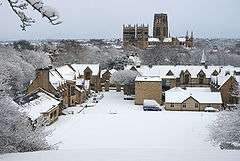 | |
| Motto |
Floreat Dunelmia (May Durham Flourish) |
|---|---|
| Established | 1414 |
| Type | Independent day and boarding school |
| Religion | Anglican |
| Head Master | K McLaughlin |
| Chairman | Alasdair MacConachie |
| Founder | Thomas Langley[1] |
| Location |
Quarryheads Lane Durham County Durham DH1 4SZ England Coordinates: 54°46′18″N 1°34′59″W / 54.771576°N 1.583024°W |
| DfE number | 840/6000 |
| DfE URN | 114331 Tables |
| Students | 642 (476 senior school, 166 Bow, Durham School) (September 2009) |
| Gender | Coeducational |
| Ages | 3–18 |
| Houses | 5 |
| Colours |
green and silver [2] |
| Former pupils | Old Dunelmians (ODs) |
| Website |
www |
Durham School is an English independent boarding school for pupils aged between 3 and 18 years. Founded by the Bishop of Durham, Thomas Langley, in 1414, it received royal foundation by King Henry VIII in 1541 following the Dissolution of the Monasteries during the Protestant Reformation. It is the city's oldest institution of learning.
The School is located in Durham, North East England and was an all-boys institution until becoming fully coeducational in 1985. A member of The Headmasters' and Headmistresses' Conference, it enrolls 650 day and boarding students. Its preparatory institution, known as Bow, Durham School, enrolls a further 160 pupils. Durham and Bow's former pupils include politicians, clergy and British aristocracy. Former students are known as Old Dunelmians.[3] The school celebrated its 600th Anniversary in 2014.
History
The history of Durham School can be divided into three sections. Firstly there is the time from its founding by Langley in 1414, then in 1541 Henry VIII refounded it, and finally in 1844 the school moved from its site on Palace Green to its current location across the river Wear. The school is often referred to in histories and the Oxford Dictionary of National Biography as "Durham Grammar School". It should not be confused with the Chorister School, Durham.
To 1541
Durham School was founded by Thomas Langley[1] in 1414, which was the foundation date accepted by the Clarendon Commission into public schools in 1861, making it the 18th oldest in Britain. It is possible, however, that it may actually have origins in the Priory at Lindisfarne, being moved to Durham City to escape marauding Viking invaders around the time that St. Cuthbert's body was brought to what is now the site of Durham Cathedral. The school was in Langley's time situated on the east side of Palace Green to the north of the cathedral.
1541 to 1844
At the time of the Dissolution of the Monasteries during the Protestant Reformation in 1541, the school was refounded by Henry VIII. It remained in the same location, indeed the Headmaster Henry Stafford remained in post, during this period. The School had some interesting times - for example, in 1640 the "old School Buildings were utterly destroyed by the Scots, and the Head Master [Richard Smelt] retired to his Rectory of Easingwold where he took pupils"[4] and the School was "recognised and endowed by the Parliamentary Commission 1652-3".[5] Homeless due to the burning down of its buildings, the school continued in various houses in the city.
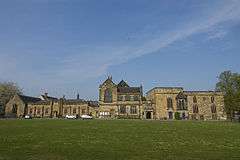
It was in 1661 that the school moved to the building currently occupied by the Durham University Music School to the north west of Palace Green.
There was some zeal for education in Durham during the 18th century. Durham School, rebuilt in 1661, on the Palace Green, soon became, instead of a local grammar school, a north-country public school of repute and wide influence. We can trace from the Restoration onwards not only the familiar city names such as Salvin, Wilkinson, Hutchinson, Blakiston, Fawcett, Bowes, Calverley, Cole. One of the chief distinctions of the school is the succession of local historians and antiquaries who drew their inspiration from the venerable association of the old school on the Green. Most famous of these is James Mickleton (1638–93), without whom no history of mediaeval or 17th-century Durham would be possible. Local history owes very much to Elias Smith, a notable head master (1640–66) who did his best to preserve the cathedral library through the Protectorate troubles, and to Thomas Rudd, head master (1691–9 and 1709–11), who indexed the Cathedral manuscripts. Later than these comes Thomas Randall (head master 1761–8), who made a large collection of manuscript material for local history books.— William Page, The city of Durham - Introduction (3 of 3) 1928.[6]
1844 to date
From its location on Palace Green outside Durham Cathedral, whilst Edward Elder was Headmaster[7] the school moved to its present site in 1844.[8]
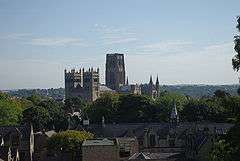
The School has been steadily expanded and updated since then. For example:
- Henry Holden, Headmaster 1853 to 1882,[9] instigated new classrooms, dormitories, kitchens, sickroom then a sanatorium, bell tower and library.[10]
- William Fearon, Headmaster 1882 to 1884, introduced the three term system used today and enlarged the playing fields and built an open air swimming pool.[10] He was also responsible, in 1882, for the concrete path alongside the River Wear between Hatfield College Boat House and Elvet Bridge.[11][12]
- Richard Budworth, Headmaster 1907 to 1932, oversaw great expansion in the School. In his tenure were added fives courts, a new boarding house in the Grove (a building now used for administration), Langley House, the Chapel (referred to below), new playing fields and classrooms, Poole House, the indoor swimming pool,[13] the armoury and rifle range and the Kerr Arch.[14] This arch, Grade II listed,[15] was erected as the front entrance to the School and is in memory of G.C. Kerr, Cambridge Rowing Blue, Scottish rugby international and first civilian governor of the Sudan.[16]
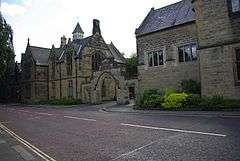
- John Brett, Headmaster 1958 to 1967, saw the building of the cricket pavilion, new kitchens and laboratories and a new sanatorium.[14]
- Michael Vallance, Headmaster 1972 to 1982, opened a Junior House of boys age 11 to 13 named Ferens House (this closed in 2003), but the main developments in his tenure were the Budworth sports centre and Luce Theatre.[14]
- The key development in Michael Lang's time, Headmaster 1982, was the introduction of girls to the Sixth Form. There was also a new classroom block near the Budworth centre.[14]
- With Neil Kern as Headmaster, the principal developments included the introduction of girls throughout the School, making it fully co-educational, followed later by the creation of MacLeod House, and the all-weather sports pitch near the Chapel.[17]
Ths school has been co-educational since 1985[18] and became independent from the Dean and Chapter of Durham Cathedral in 1996.[19]
School site
The school is located to the west of Durham Cathedral and across the River Wear from it. The campus consists of a range of buildings, some of them listed,[15] and sports fields. The school has a boathouse located on the bank of the river, just downstream of Prebends Bridge.
Chapel and war memorial
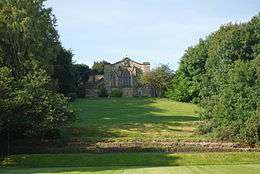
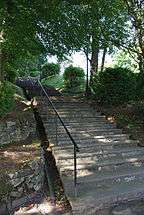
The school chapel, built from 1924 to 1926 during the tenure of Richard Budworth as headmaster,[20] sits on top of a hill overlooking the main school site.
The building is used for services four times a week, with the major service held on Friday evenings, that the majority of pupils attend. The School is within the Anglican tradition.
The chapel is also the war memorial, its walls are engraved with the names of those who died in World War I and the further 79[21] who died in World War II. There are 97 steps to the chapel, one for each of the Old Dunelmians who died in World War I.[22] (Note that the UKNIWM reference and Durham School's disagree on the number of World War I dead - 97 or 98.) The steps were re-laid in 1954.[14]
A further war memorial, which predates the building of the Chapel, can be seen in St Margaret's, the local Parish Church. It consists of a large brass panel listing the names of former pupils fallen in the First World War and is fixed on the south side of the Chancel arch, with the Parish memorial facing it on the north side.

Academic results and subjects
Subjects
A/AS Level
The School offers a range of subjects at A/AS Level, this varies from year to year as the needs of the students and the School change. Most students choose four subjects at AS Level, dropping to three at A2 Level.[23]
GCSE
Durham School, in common with most other schools, offers a varied curriculum at GCSE where students study mathematics, English Language and Literature and science (either the individual physics, chemistry and biology or a double award science course). All students study a core modern foreign language of either French, German or Spanish. There are then a number of options that the students can choose from.
Key Stage 3 (Years 7 to 9)
Durham School offers a range of subjects to students in Years 7 to 9 that lead into the GCSE programme starting, generally, in Year 10, with the exception of those in set 1 maths, who do their maths GCSE a year early. They start their course in year 9.
Results
Durham School students cover a wide range of abilities from the academically gifted to those whose talents lie in other areas,[24] This is reflected in the results that the School achieves as a whole. Value added- the measure that assesses results against a benchmarked baseline ability test - is very good. The School states that "We aim to bring out the best in every pupil and work together with them to ensure that the grades they achieve in their public examinations are a true reflection of their full potential."[25]
Pastoral care
Pastoral care at Durham School is based around the house system:
House system
Although lessons are co-educational and sport takes place generally in year groups, for pastoral and sporting competition purposes, the school is divided into five different single sex houses.[26] Each student is assigned to a house at the start of his or her time in the school and will, usually, remain in that house for the whole of their school career. The houses are separate buildings each with its own character in which the students are able to use the facilities and do private study. Currently the houses comprise:
| House | Occupants | Founded | House colour |
|---|---|---|---|
| School | boys, boarding and day | 1844 | |
| The Caffinites | boys, boarding and day | 1847 | |
| Poole | boys, boarding and day | 1924 | |
| Pimlico | girls, boarding and day | 1985 | |
| MacLeod | girls, day | 2005 |
School House boys are often nicknamed Bungites after the Headmaster Henry Holden who was also their Housemaster and himself nicknamed 'Bung' due to his ability to tell tall tales.[10]
The Caffinites was also called The Second Masters House until it was renamed in 1924.
Co-curricular
Sport
With facilities that encompass playing fields, swimming pool, all-weather pitch and boathouse, Durham School has a wide-ranging sports programme that includes athletics, badminton, cricket, cross country, fencing, football, gym, hockey, netball, rounders, rowing, rugby, squash, swimming, tennis, golf and water polo.[27]
Cricket
Along with rowing, cricket is the major boys sport for the summer term. The school considers cricket to be one of its high-profile sports, with the 1st XI competing against a number of high-profile teams such as the MCC.[28][29] The cricket pavilion was built in 1960.[14]
Hockey
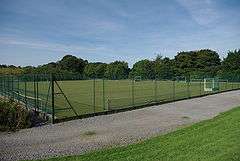
The main sport for girls in winter is hockey. Each year a number of girls represent the county. Hockey is also played by the boys, predominately in the Easter term.[30]
Rowing
Rowing has been a major sport at Durham School since at least 1838,[31] and today it continues to flourish. The Club aims to provide rowing opportunities to any who wish to be involved - "All year groups at the school have the opportunity to row at the appropriate level for their physiological and physical development"[32] - and also wins at regattas and head races at home and abroad. In addition, the Club offers rowing to students, parents, friends and other local schools.
Rugby
The School has a number of playing fields, used predominately for Rugby. The largest of these, Top Ground, was acquired in 1918.[14] This has required work on its drainage over the years, 1921 and 1925[14] and again in 2009.
Durham School is the fourth or fifth oldest football club of any kind in the world[33][34] and has produced many international rugby union players as well as introducing the game to Scotland.[34] Durham School Football Club was founded in 1850[35] and was from 1890-1930 one of the rugby nurseries in England - this was first recognised by the Barbarians who honoured the school by playing a full side against the Old Dunelmians in 1897 (Barbarians won 18-5). Just before the First World War the school supplied four England players as well as a number of England trialists. Between 1920 and 1930 the school produced seven full internationals as well as several trialists (England, Scotland and British Lions). The headmaster during this great period was Richard Thomas Dutton Budworth who was himself a former England international and Barbarian.[36] The history of the sport is celebrated in the annual Veterrimi IV Rugby Tournament.[37]
Newcastle Falcons (originally Gosforth) rugby union club were founded as the old boys side and played in the school's colours until recently (green and white hoops).[38]
Combined Cadet Force
The Combined Cadet Force (CCF) is a Ministry of Defence sponsored youth organisation within schools in the UK. Durham School CCF has been running since it was formed as the Officer Training Corps (OTC) in 1914.[39] The CCF is based in the Armoury and Range (previously there had been an air rifle range set up in the School House lavatories in 1906[40]) built in 1926 and 1929 respectively.[14] Currently the CCF is a voluntary activity that students may opt into from Year 9 onwards consisting of three sections,[41] The Royal Navy, The Army and The Royal Air Force.
Music
Centred on the Grade II listed Music School,[42] Music is an important aspect of life at Durham School with a high profile in the School itself and also known in the region as a whole with concerts at The Sage Gateshead and in Durham Cathedral from time to time. The School offers music as an academic subject at both GCSE and A Level.[43]
Drama
Centred on the Luce Theatre, also Grade II listed,[42] a versatile space named after Cannon Henry Luce, Headmaster 1932 to 1958, drama at Durham School is a key part of the academic and extra-curricular provision. Productions are varied and take place two or three times per year for different age groups.[44]
Bow, Durham School
| Established | 1885[45] |
|---|---|
| Type | Independent school, Preparatory School |
| Religion | Anglican |
| Head Master | R.N. Baird |
| Location |
South Road Durham County Durham DH1 3LS England |
| Students | 166 (September 2009) |
| Gender | Coeducational |
| Ages | 3–11 |
| Website |
www |
Bow, Durham School is the Durham School preparatory institution for pupils between the ages of 3 to 11 years. Founded in 1885 as Bow School, it was an all-male institution until becoming coeducational in 2006.[46] The campus is situated one-half mile to the east of the senior school, overlooking the World Heritage Site, Durham Cathedral.[46] Former pupils are known as "Old Bowites" and several prominent alums include British politicians and nobles, such as William Fletcher-Vane, 1st Baron Inglewood, Sir Brian Horrocks and Sir Gilbert Longden, and a number of professional sportsmen, such as Michael Philip Weston.[47]
Notable past pupils: Old Dunelmians
The past pupils of Durham School, referred to as Old Dunelmians, have been, and continue to be, found across the spectrum of public life, the armed services, the arts, the church and in sport. "Dunelmian" is derived from Dunelmensis, the Latin adjective of Durham. Their number include:
- Alexander Armstrong,[48] the actor known for playing "Reg Arwell" in "Doctor Who".
- Michael Gough,[49] the actor best known for playing "Alfred" in the first four of the modern Batman films and comedian;
- Field Marshal Henry Hardinge, 1st Viscount Hardinge,[50] commander in chief of the British Army after The Duke of Wellington;
- Anthony Salvin,[51] the architect of national fame;
- Granville Sharp,[52] founder of Sierra Leone;
- Ian Gregg, the ex-CEO of Greggs bakers, businessman;
- Geoff Parling, the England rugby national;
See also
References
- 1 2 Fraser, C. M. "Langley, Thomas (c.1360–1437)". Oxford Dictionary of National Biography (2004). Retrieved 9 September 2009.
...he also founded a chantry in the Galilee chapel of Durham Cathedral, his designated burial place, whose two chaplains were to teach grammar and song to poor children freely—the forerunner of Durham School.
- ↑ Baty, D.; Gedeye, N.G.E., eds. (1991). Durham School Register (Fifth Edition to 1991 ed.). Durham City: Durham School. p. 13. ISBN 0-9515730-0-4.
The School Sports Colours, green and silver, are incorrect for the school shield. They come from the personal coat of arms of Cardinal Langley who reorganised and endowed the School in 1414
- ↑ http://www.durhamschool.co.uk/old-dunelmiansdistinguished.asp
- ↑ Earle, Charles; Body, Lawrence, eds. (1912). Durham School Register (Second ed.). Durham City: Durham School. p. 20.
- ↑ Earle, Charles; Body, Lawrence, eds. (1912). Durham School Register (Second ed.). Durham City: Durham School. p. 21.
- ↑ William Page (ed.) (1928). "City of Durham". A History of the County of Durham: volume 3. Victoria County History. pp. 29–53. Retrieved 2009-08-25.
- ↑ Vian, Alsager; rev. M. C. Curthoys. "Elder, Edward (1812–1858)". Oxford Dictionary of National Biography (2004; online edn, Oct 2005). Retrieved 7 August 2010.
Elder, Edward (1812–1858), headmaster, the son of John William Edmund Elder, was born in Barbados on 1 October 1812. ... He was a tutor at Oxford until 1839, when he became headmaster of Durham Cathedral grammar school. The school was in a sorry state, but was transformed during Elder's headmastership, ultimately acquiring the standing of a public school, helped by the move to a new site in 1844.
- ↑ Malden, John (1996). Let Durham Flourish. Durham City: The Friends of Durham School. p. 8. ISBN 0-9528670-0-1.
The School moved from Palace Green to its present site in 1844.
- ↑ Hughes, C.E.; rev. Richard Smail. "Holden, Hubert Ashton (1822–1896)". Oxford Dictionary of National Biography (2004; online edn, Oct 2009). Retrieved 7 August 2010.
Henry Holden (1814–1909), classical scholar and headmaster, was born at Birmingham on 7 July 1814, the second son of Henry Augustus Holden (1785–1870), a clergyman, and his wife, Mary Willetts Holden. ... Holden was headmaster of Durham Cathedral school from 1853 until 1882, then vicar of South Luffenham, Rutland, from 1881 until 1898.
- 1 2 3 Malden, John (1996). Let Durham Flourish. Durham City: The Friends of Durham School. p. 8. ISBN 0-9528670-0-1.
- ↑ Macfarlane-Grieve, Captain A.A., ed. (1922). A History of Durham Rowing. Newcastle-upon-Tyne: Andrew Ried and Company, Limited. p. 53.
This year [1882] also was constructed a new concrete path between the Hatfield Hall boathouse and Elvet Bridge. Rowing men are indebted to the Rev. W.A. Fearon, at that time Headmaster of Durham School, for this improvement. Before this date it had been necessary for those running with the boats to cross the river at Elvet Bridge, and the proceed by way of New Elvet to the river bank at St. Oswald's Church, which made coaching from the bank a much more difficult undertaking than it is at present.
- ↑ Macfarlane-Grieve, Captain A.A., ed. (1922). A History of Durham Rowing. Newcastle-upon-Tyne: Andrew Ried and Company, Limited. p. 189.
At a meeting held in March, 1884, the Honorary Secretary [of Durham Amateur Rowing Club] was instructed to forward a vote of thanks from the Officers and members of the Club to the Rev. W.A. Fearon, M.A., Headmaster of Durham School, for his great generosity in building the wall and constructing a footpath below Hatfield Hall and connecting Elvet Waterside with that part of the banks known as Bow Corner. Present rowing men can hardly realise what the conditions were, both for coaching and following the long course races, before this useful walk was completed. Residents, other than those interested in rowing, have certainly reaped the benefit of this convenient and pleasent walk along the river.
- ↑ Baty, D.; Gedeye, N.G.E., eds. (1991). Durham School Register (Fifth Edition to 1991 ed.). Durham City: Durham School. p. 11. ISBN 0-9515730-0-4.
- 1 2 3 4 5 6 7 8 9 Malden, John (1996). Let Durham Flourish. Durham City: The Friends of Durham School. p. 9. ISBN 0-9528670-0-1.
- 1 2 "Durham School South Building, Quarryheads Lane; Listed building (Durham City)". Retrieved 24 August 2010.
This is a group of school buildings at Durham School. The south building was built in 1843 by Salvin and Pickering and includes the remains of an earlier building. The frontage building, which stands on Quarry Heads Road is of slightly later date. The gateway dates to 1927 and was built as a memorial to Graham Campbell Kerr. This is a Grade II Listed Building protected by law. Listing NGR: NZ2694341965
- ↑ Malden, John (1996). Let Durham Flourish. Durham City: The Friends of Durham School. p. 51. ISBN 0-9528670-0-1.
...in memory of G.C. Kerr ... Cambridge Rowing Blue & Scottish Rugger International, who was first civilian governor of the Sudan.
- ↑ "Future Development". Durham School. Retrieved 13 August 2010.
Recent projects include the upgrading of the existing two ICT labs (2004), the creation of a third ICT Suite (2005), the building of an all-weather sports facility (2004), the creation of a new girls' house (2005), a new build extension of the girls’ day house (2006), redevelopment of the theatre (2006), refurbishment of all houses (2005-07), ICT networking (2005-07), catering refurbishment (2005-06).
- ↑ Wilson, Karen (10 January 2008). "Independent schools offer the very best start". The Journal. Retrieved 28 August 2009.
- ↑ Malden, John (1996). Let Durham Flourish. Durham City: The Friends of Durham School. p. 9. ISBN 0-9528670-0-1.
In 1996 the School gained its independence from the Dean and Chapter.
- ↑ Malden, John (1996). Let Durham Flourish. Durham City: The Friends of Durham School. p. 9. ISBN 0-9528670-0-1.
Budworth's greatest legacy is the School Chapel, built between 1924 and 1926 as a memorial to those who died in the First World War.
- ↑ "Chapel". Durham School. Retrieved 29 November 2009.
The Chapel was built in the 1920s as a memorial to the 98 Old Dunelmians who died in the First World War. During the Second World War a further 79 Old Dunelmians were killed, and the names from both wars are inscribed on the pillars inside the Chapel.
- ↑ "UK National Inventory of War Memorials entry". UKNIWM. Retrieved 27 August 2009.
- ↑ "Durham School Academic Curriculum". Durham School. Retrieved 11 August 2010.
- ↑ "Durham School Academic Exam Results". Durham School. Retrieved 11 August 2010.
Our pupils cover a wide range of different ability levels from the academically gifted (who will eventually win a place at Oxford or Cambridge) to the girl or boy who will have to work extremely hard and with considerable support for her/his academic success.
- ↑ "Durham School Academic Exam Results". Durham School. Retrieved 11 August 2010.
- ↑ "Houses at Durham School". Durham School. Retrieved 6 August 2010.
Every girl and boy at Durham School belongs to a House and the Houses are at the very heart of our community. The House is much more than just a focus for competitions, as it is in many schools. At Durham School each House has its own distinct building with excellent facilities for private study and leisure. It is the place where pupils go first in the morning, where they return to frequently during the school day and from where they are most likely to leave in the evening. In fact, pupils, and indeed their parents, see it as a "home from home". It is our House system and all that it offers and means to our pupils that sets us apart from many of our competitors.
- ↑ "Sport at Durham School". Durham School. Retrieved 28 August 2009.
- ↑ "Cricket at Durham School". Durham School. Retrieved 30 August 2010.
- ↑ "2010 Fixtures". MCC. Archived from the original on July 1, 2010. Retrieved 11 September 2010.
[MMC] Won by 113 runs
- ↑ "Hockey at Durham School". Durham School. Retrieved 30 August 2010.
- ↑ Macfarlane-Grieve, Captain A.A., ed. (1922). A History of Durham Rowing. Newcastle-upon-Tyne: Andrew Ried and Company, Limited. p. 8.
In a letter of the late Canon Tristam we read "The first boat the School ever put on the river was a four-oar wherry named the 'Argo' in 1838".
- ↑ "Rowing at Durham School". Durham School. Retrieved 1 September 2009.
- ↑ "The History of Rugby". Retrieved 18 October 2009.
- 1 2 "Rugby Union History". The Rugby Factory Shop. Retrieved 18 August 2010.
Rugby football has strong claims to the world's first and oldest "football club": the Guy's Hospital Football Club, formed in London in 1843, by old boys from Rugby School. Around the anglosphere, a number of other clubs formed to play games based on the Rugby School rules. One of these, Dublin University Football Club, founded in 1854, has arguably become the world's oldest surviving football club in any code. The Blackheath Rugby Club, in London, founded in 1858 is the oldest surviving non-university/school rugby club. Cheltenham College 1844, Sherborne School 1846 and Durham School 1850 are the oldest documented school's clubs. Francis Crombie and Alexander Crombie introduced rugby into Scotland via Durham School in 1854.
- ↑ "History". DURHAM COUNTY RUGBY FOOTBALL UNION. Retrieved 18 October 2009.
- ↑ "Richard Thomas Dutton Budworth". Clifton Rugby Football Club. Retrieved 18 October 2009.
- ↑ "V4 Rugby Tournament A Huge Success". Durham School. Retrieved 26 October 2010.
The inaugural Veterrimi IV Rugby Tournament, hosted by Durham School, took place on Saturday 23 October and despite the unrelenting rain, rugby fans turned out in their hundreds to be part of this special day. Durham School and Rugby School battled it out in the final, with the A J Dingle Trophy finally going to Rugby School.
- ↑ "Profile of Newcastle Falcons". ITV. Retrieved 28 August 2009.
- ↑ Malden, John (1996). Let Durham Flourish. Durham City: The Friends of Durham School. p. 118. ISBN 0-9528670-0-1.
- ↑ Malden, John (1996). Let Durham Flourish. Durham City: The Friends of Durham School. p. 9. ISBN 0-9528670-0-1.
Also in 1906 an 'air rifle range has been set up in Bungite [School House] lavatories, with fised and moving targets and it has been used regularly after tea
- ↑ "Combined Cadet Force CCF at Durham School". Durham School. Retrieved 17 October 2011.
Our CCF is made up of three sections: Navy, Army and RAF. It is currently a voluntary activity which all pupils have the option of starting in Year 9.
- 1 2 "Durham school luce music centre and porter's lodge; Listed building (Durham City)". Keys to the Past. Retrieved 24 August 2010.
Durham School Luce Music centre was originally built as a lodge, gymnasium, music room, workshop and laboratory for the school in 1889-1904. This is a Grade II Listed Building protected by law. Listing NGR: NZ2690141969
- ↑ "Music at Durham School". Durham School. Retrieved 29 November 2009.
Music at Durham School enjoys a high profile within the School and in the wider community. We try to ensure that practical music making is made as inclusive as possible for all pupils, throughout the School whilst striving for the highest possible musical standards at all levels. Academic music is given a high priority and the School’s pupil musicians are encouraged to study music at GCSE and A level. We endeavour to motivate and enthuse all musicians and potential musicians within an environment which promotes high values, a sense of community and, above all, a sense of achievement and enjoyment.
- ↑ "Drama at Durham School". Durham School. Retrieved 29 November 2009.
Drama at Durham School has a long and distinguished tradition. It is centred at the Luce Theatre, a versatile space that has housed many different types of production and is now the base for curriculum drama lessons. Musicals, comedies, farces, costume drama, sketch shows and tragedy all have their place here. The Luce Theatre was totally re-furbished and its technical provision upgraded in the Summer of 2006.
- ↑ "About The Prep School". Durham School. Retrieved 7 September 2009.
- 1 2 "Prep School". Durham School. Retrieved 28 August 2009.
- ↑ http://www.durhamschool.co.uk/old-bowites.asp
- ↑ "Durham School". Guide to Independent Schools. Retrieved 1 November 2009.
- ↑ "Michael Gough". The New York Times. Retrieved 8 November 2009.
Education: Wye Agricultural College, England; Bristol Old Vic Theatre School, England, Major - drama; Durham School, England; Rose Hill School, Kent, England
- ↑ Howlett, David J. "Hardinge, Henry, first Viscount Hardinge of Lahore (1785–1856)". Oxford Dictionary of National Biography (Sept 2004; online edn, Jan 2008). Retrieved 9 September 2009.
Hardinge passed much of his childhood at The Grove near Sevenoaks amid a deeply religious tradition and in the care of two maiden aunts, and went to school at Durham.
- ↑ Holder, Richard. "Salvin, Anthony (1799–1881)". Oxford Dictionary of National Biography (2004). Retrieved 22 September 2009.
After education at Durham School Salvin was placed as a pupil with John Paterson of Edinburgh during the latter's restoration work on Brancepeth Castle.
- ↑ Ditchfield, G. M. "Sharp, Granville (1735–1813)". Oxford Dictionary of National Biography (Sept 2004; online edn, Jan 2008). Retrieved 9 September 2009.
According to Prince Hoare, his first biographer, Granville: was at a very early age withdrawn from the public grammar-school at Durham, before he had gained more than the first rudiments of the learned languages, and was sent to a smaller school, to be instructed more particularly in writing and arithmetic.
External links
- School website
- Bow, Durham School
- Old Dunelmians website
- Independent Schools Inspectorate Inspection Reports
- Profile at the Independent Schools Council website